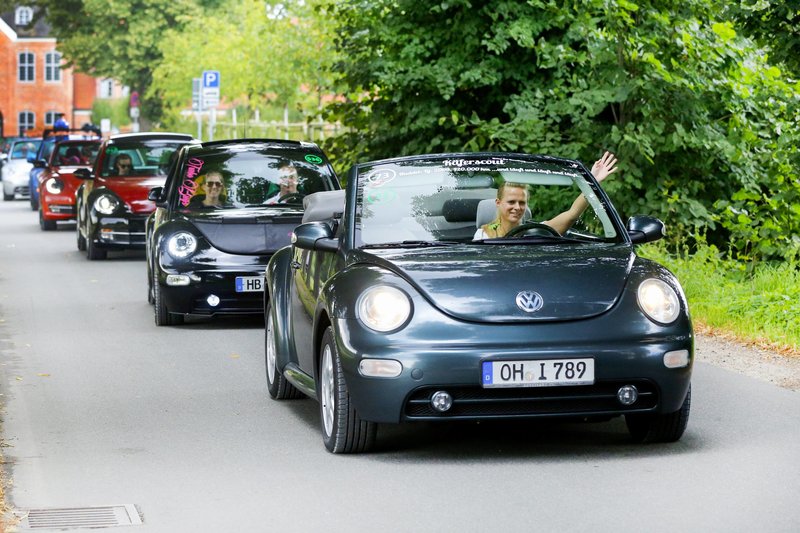美國前官員揭德企黑歷史

2016年8月20日,,第12屆“甲殼蟲陽光行”車聚派對在德國呂貝克的特拉弗明德舉行,,圖為活動上的甲殼蟲汽車,。
Franziska Krug—Getty Images for Beetle Sunshine
|
10只看動畫片的長尾獼猴,與柴油車的安全性有什么關(guān)系,? 本來沒什么關(guān)系,。不過如果你看過Netflix最近出品的紀(jì)錄片《臟錢》,你會就會知道,,2014年在美國新墨西哥州阿爾伯克基市郊區(qū)的一座實驗室里,,這些猴子擠在一間封閉的小隔間中,而一輛大眾甲殼蟲轎車的尾氣直接排在猴子們所處的小隔間里,。這次實驗是由一個名叫歐洲運輸業(yè)環(huán)境與健康研究會(EUGT)的德國汽車行業(yè)機構(gòu)出資贊助的,。 拿猴子作實驗并不是最令人氣憤之處。由于在軟件上作了弊,,這輛甲殼蟲的尾氣有毒物質(zhì)含量實際上超標(biāo)了40倍,。一系列測試結(jié)果證明,,這輛大眾甲殼蟲的污染水平比一輛1997年產(chǎn)的老款福特皮卡還厲害,有關(guān)公司因此決定不對外公布測試結(jié)果,。 這次猴子實驗是在阿爾伯克基市的洛克萊斯呼吸病研究所進行的,,EUGT是此次實驗的贊助商。實驗?zāi)康氖且贸龌蛘哒f捏造出“科研成果”,,證明新技術(shù)已經(jīng)使柴油變得安全了,。而EUGT的所有撥款都來自大眾、戴姆勒和寶馬,。由于它的工作備受爭議,,這家機構(gòu)也于去年關(guān)停,。 要想在柴油問題上拿出有利于汽車行業(yè)的數(shù)據(jù),,當(dāng)然是非常不容易的。歐洲之所以在90年代大搞柴油車,,是因為柴油車排放的溫室氣體要少于同類的汽油車,。但是等到了“猴子實驗”的時候,柴油車的負(fù)面影響已經(jīng)吸引了越來越多人的關(guān)注,。 歐洲議會發(fā)布的一份報告顯示,,2012年,歐洲有72,000人因二氧化氮污染而早逝,。有些歐洲城市已經(jīng)劃設(shè)了限制或禁止柴油車通行的區(qū)域,。上月德國最高聯(lián)邦法院也出臺了一項重要規(guī)定,宣布各個城市有權(quán)自行決定禁止柴油車上路,。而在上書請愿禁止柴油車的城市中,,奔馳和保時捷的老家——斯圖加特也赫然在列。 大眾等德國汽車公司都想通過所謂的“科研成果”刺激柴油車在美國的銷量,。不過在經(jīng)歷了“柴油門”和2015年的大眾汽車排放測試作弊事件后,,德國廠商的“柴油熱”也徹底涼了下來,那次作弊事件也導(dǎo)致大眾蒙受了300多億美元的損失,。 當(dāng)我聽說這些測試時,,我首先想到了我在美國環(huán)境保護署工作的這32年多的經(jīng)歷。當(dāng)年我在擔(dān)任環(huán)保署輻射與室內(nèi)空氣處主任時,,我們發(fā)布了第一份關(guān)于吸二手煙的危害的報告,。結(jié)果我們的報告遭到了煙草行業(yè)的激烈反對,他們馬上搞了一系列有誤導(dǎo)性的科學(xué)試驗來混淆視聽,,妄圖讓老百姓罔顧吸煙的安全風(fēng)險,。為了證明他們的產(chǎn)品是安全的,不少煙草公司也在一系列動物身上搞了非常類似的實驗,。 跟吸煙不同的是,,柴油引擎對我們還是有益處的,,它在全球貨運體系中扮演了不可或缺的角色,另外柴油也不是不能做得更清潔些,。后來在我擔(dān)任環(huán)保署交通空氣質(zhì)量處主任期間,,我掀起了一場后來所謂的“清潔柴油”運動。2000年重型柴油機規(guī)定出臺后,,我們圍繞清潔柴油燃料采取了一些監(jiān)管行動,,將有毒柴油機廢氣減少了95%。 重型柴油機規(guī)定出臺后,,我們估計平均每年避免了8300人的早逝,,使75萬人免于遭受呼吸系統(tǒng)疾病的侵襲。美國健康影響研究所近期研究表明,,現(xiàn)代柴油發(fā)動機的尾氣毒性已遠(yuǎn)低于以前的高污染柴油引擎,。但是,所謂的“清潔柴油”也并不是完全清潔的,。 關(guān)于這個問題,,汽車業(yè)的一個通病就是作弊成風(fēng),同時對標(biāo)準(zhǔn)不能一以貫之地執(zhí)行,。我在交通空氣質(zhì)量處當(dāng)主任的18年間處罰過的汽車廠商,、柴油發(fā)動機廠商和卡車制造商中,有的甚至里用高污梁產(chǎn)品作弊長達10年以上,。就在上個月,,梅賽德斯奔馳還曝出了作弊事件。另外,,從美國環(huán)保署現(xiàn)任署長斯科特?普瑞特最近的一些行動上也不難看到金錢和政治的影子,。環(huán)保署最近向高污梁柴油卡車開了綠燈,就是在他的授意下做的決定,。 那么,,我們怎樣才能讓柴油發(fā)動機變得徹底安全呢?現(xiàn)實地說,,根本做不到,。在我們所知的范圍內(nèi),只有一個持續(xù)有效的戰(zhàn)略能解決柴油對人體健康和氣候變化的影響,,那就是推動整個運輸體系電動化,。電動汽車不排放尾氣,也能緩解氣候變化帶來的影響,。 有人稱,,隨著電動汽車的發(fā)展,電燃引擎汽車剩下的日子已經(jīng)不多了。對于輕型車輛或許如此,,但對于中型特別是重型車輛來說,,在電動汽車的技術(shù)和基礎(chǔ)設(shè)施平價化、普遍化之前,,柴油可能還得繼續(xù)扮演一定的角色,。 在乘用車持續(xù)電動化的同時,我們也不能放松對柴油技術(shù)的關(guān)注,。我們要繼續(xù)推動柴油發(fā)動機技術(shù)的進步,,特別是要認(rèn)真執(zhí)行相關(guān)規(guī)定,確保降低柴油機對健康的影響,,同時將它對環(huán)境的影響降至最低,。 不過要達到這個目標(biāo),并不需要汽車公司給猴子灌尾氣做實驗,。(財富中文網(wǎng)) 本文作者Margo Oge曾在美國環(huán)境保護署工作32年,,曾于1994年至2012年間任美國環(huán)保署交通與空氣質(zhì)量處主任,她也是美國2025 GHG/CAFé標(biāo)準(zhǔn)的主要起草者,。她也是《駕馭未來:用清潔智能汽車對抗氣候變化》一書的作者,。 譯者:樸成奎 |
What do 10 long-tailed macaque monkeys watching cartoons have to do with making diesel safer? Ideally nothing, but if you watched the recent Netflix documentary Dirty Money, you would see a lab outside of Albuquerque in 2014, where these primates are sitting in air-tight compartments while a Volkswagen Beetle’s diesel fumes are pumped inside. It was as part of an experiment paid for by the European Research Group on Environment and Health in the Transport Sector (EUGT), a German auto industry group. But it’s actually worse than all that. The Beetle was 40 times the legal limit due to software that cheated the system. The tests proved that the VW car was polluting morethan an old, 1997-year Ford truck, and the companies decided not to publicly release the test results. The monkey experiment, conducted at the Lovelace Respiratory Research Institute in Albuquerque, was sponsored by EUGT. The goal was to create (bogus) scientific research proving that new technology had made diesel safe. EUGT received all of its funding from Volkswagen, Daimler, and BMW. It shut down last year amid controversy over its work. There was a lot at stake for the companies to produce industry-friendly data. Europe embraced diesel in the 1990s because, on average, diesel cars and trucks produce fewer greenhouse gases than similar gasoline vehicles. But, by the time of the monkey experiments, the negative health effects of diesel were getting more attention. A report released by the European Parliament showed that 72,000 people in Europe died prematurely because of nitrogen dioxide pollution in 2012. Some European cities are creating zones that restrict diesel vehicles, or banning them outright. In Germany, the highest federal court issued a landmark ruling last month that cities have the right to ban diesel cars. One of those cities petitioning the court for a ban was Stuttgart, the home of Mercedes and Porsche. Volkswagen, along with the other German auto companies, also wanted to use the research to increase their diesel sales in the United States. That came to a screeching halt with “Dieselgate” and VW’s emissions cheating scheme in 2015, which has cost the company more than $30 billion. When I learned about these tests, my mind immediately flashed back to events in my 32-plus year career with the U.S. Environmental Protection Agency. First, it was the time I was the director of the Office of Radiation and Indoor Air (ORIA), where we developed the first report about the dangers of secondhand smoke. Our report got massive pushback from the tobacco industry, which created a variety of misleading research designed to confuse the public about the massive health risks of their products. Cigarette companies had, in fact, run very similar tests on a variety of animals to prove that their products were safe. But unlike smoking, diesel engines serve a purpose, are an integral part of the freight transportation systems of the world, and can be made cleaner. Later in my EPA career, as director of the Office of Transportation Air Quality (OTAQ), I led the effort that ended up becoming known as “clean diesel.” With the Heavy Duty Diesel rule in 2000, we took regulatory action to clean diesel fuel and reduce toxic diesel exhaust by 95%. As a result of this rule, 8,300 premature deaths and 750,000 respiratory illnesses were expected to be prevented annually. Recent studies by the Health Effects Institute concluded that the overall toxicity of modern diesel engines are significantly lower than the high-polluting older engines, but even “clean diesel” is not perfectly clean. What exacerbates the situation today is endemic cheating and the lack of consistent enforcement of the standards. In my 18 years as director of OTAQ, we had fined car manufacturers and diesel engine and truck companies that were cheating with polluting trucks for over a decade. Just last month, new revelations emerged about alleged cheating by Mercedes Benz. And, there is money and politics as witnessed in the recent actions of Scott Pruitt, the current EPA administrator, who is behind a decision to give compliance waiver to the highly polluting diesel truck “glider kits.” So, how can we make diesel engines completely safe? Realistically, we can’t. There is only one known, long-lasting strategy to address both human health and climate change: move to electrification of our transportation system. Electric vehicles have no emissions and help mitigate the environmental challenge of our time: climate change. Some say the internal combustion engine’s days are numbered, and that may be true for light-duty vehicles nearing the “tipping point” for electric vehicles. But in medium-duty and especially heavy-duty vehicles, diesel will continue to play a role as we wait for technologies and infrastructure to become more economically feasible. While the passenger vehicle sector is getting electrified, we cannot take our eye off diesel technology. It will be important to continue improvements to diesel engines—and especially enforcement of the rules—to ensure that their health effects continue to be reduced and their contribution to climate change is minimized. But that doesn’t require industry studies of gassed monkeys. Margo Oge served the United States Environmental Protection Agency for over 32 years and most recently, was the director of the EPA’s Office of Transportation and Air Quality (OTAQ) from 1994 to 2012 and a key architect of the 2025 GHG/CAFE Standards. She is also the author of the book, Driving the Future: Combating Climate Change with Cleaner, Smarter Cars. |













